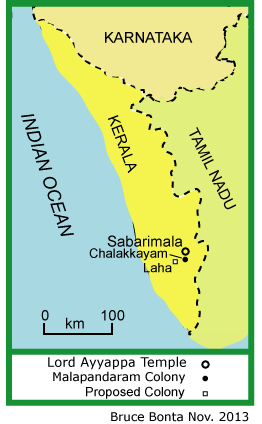Nearly 17 months after writing a report about a Malapandaram community in Kerala, Radhakrishnan Kuttoor, a reporter for The Hindu, returned to see how the same community is doing. The reporter, focusing his story last week on issues similar to the ones in 2013, referred to the situation in the community as a “tale of poverty, tears, and exploitation.”
 He brings an urban bias to his article when he describes the campsite of the Malapandaram. They hang a hurricane lamp from the branch of a tree, their only source of light at night, the journalist writes, “and they live in perpetual fear of wild beasts and anti-social elements.” He speaks with Bhavani, a woman he describes as middle-aged, who tells him about their life in the forest. The streams dry up so they have to venture deeper into the woods for water, “braving the threat posed by wild animals.”
He brings an urban bias to his article when he describes the campsite of the Malapandaram. They hang a hurricane lamp from the branch of a tree, their only source of light at night, the journalist writes, “and they live in perpetual fear of wild beasts and anti-social elements.” He speaks with Bhavani, a woman he describes as middle-aged, who tells him about their life in the forest. The streams dry up so they have to venture deeper into the woods for water, “braving the threat posed by wild animals.”
Bhavani tells Mr. Kuttoor that they have not been receiving provisions from the authorities for five months, so their children have taken to picking up stray bits of food discarded by passersby along the roads. She tells the reporter that they could go into the town of Attathode to purchase groceries and rice, but they don’t have the money to buy such provisions.
The people are reluctant to give up their lives in the wilds, but sources of forest-based income have dried up, says P.S. Uthaman, a Malapandaram leader. The reporter hears allegations that middlemen are exploiting them by buying the forest products they bring out for sale, unfairly paying them low rates and then selling the products for much more. Mr. Uthaman also tells Mr. Kuttoor that the Malapandaram in the camp have health problems, especially malnutrition and anemia among the women and children
Mr. Uthaman believes that the people should be rehabilitated at a new settlement, near a place called Laha. There, they would be close to their beloved forests but they could still have the advantages of outside human products and services. The reporter adds that Tribal Welfare Department officials frequently have a hard time locating these people because of their nomadic ways.
Another news service reported later the same day that the piece in The Hindu had prompted administrators of the district Tribal Welfare Department to take very seriously the criticism. District Collector S. Harikishore said that his administration would see that the Malapandaram people in both communities discussed by the story in The Hindu, Nilackal and Chalakkayam, were provided with food, water, and appropriate health care services.
K. Mukundan, the District Tribal Development Officer, told the reporter that the department intended to set up a new settlement for 25 Malapandaram families from Nilackal, Plappally, and Chalakkayam on a 4.04 hectare tract at Manjathode, near Laha. This appears to be the same plan that another District Tribal Development Officer had described in the 2013 news story, though that earlier official had said that 26 families would be rehabilitated.
Mr. Mukundan said the Malapandaram seldom wanted to live in permanent communities, but he indicated that some of the young people are interested in the proposed tribal settlement near Laha. The Tribal Welfare Department has forwarded a request to the Forest Department for permission to divert the 4.04 hectares of forest land to the new tribal settlement, but the proposal is still pending.
He added that his department has deposited 13,300,000 rupees (U.S.$213,000) with the Kerala Police Housing Construction Corporation for establishing the new tribal settlement.